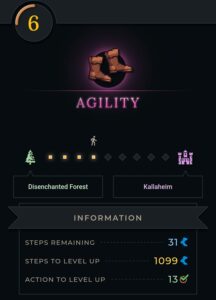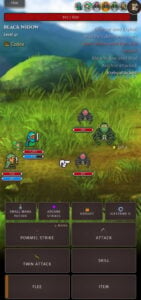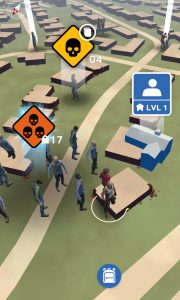
In our last Massively on the Go, we talked about the top five features location-based games keep using but shouldn’t. The genre is relatively young and largely poorly imitated even by its largest (and most problematic) developer. But not all is lost! In fact, I’d argue that some of the best aspects of location-based games come directly from MMOs. Let’s set aside genre’s behemoth, which gets by mostly on IP power, and talk about features other location-based games have successfully used to date.

Exercise motivation/paraphernalia
If there is just one feature on this list developers should remember, it’s this one. I think it may be one of the reasons the upcoming exercise game, WalkScape, which is not a location-based game, has generated some decent interest from readers.
It’s not just WalkScape, though. While I was working on the previous article and lamenting issues with the genre on social media, Orna PR slid me a note that says that studio has an upcoming “system that aims to get Orna players walking with a new content type, integrating with the phone step counters for fitness tracking,” and it’ll apparently be something the studio can “build on for years.”
I mention this because, frankly, few games seem to consider using GPS for anything more than slowing down progress. By attaching GPS play to (combat) grinding, games ensure all the player really gets is a slowed-down version of pretty much any non-GPS game. Now, admittedly, you could argue the same thing for a step counter, except that the step-counter is motivation for exercise – that is, the game grants virtual bonuses, but that’s to help promote real-world health.
The MMOARG/location-based genre isn’t just about fitness; it’s also about going out into the world, which is more rewarding when we don’t have to constantly stare at our screens. By having a connection to some other device or app that runs makes our real-world work translate into virtual rewards, games make it easier for the players to feel rewarded for doing something good for themselves. At the same time, though, you don’t want something that’s totally passive.
 Group play
Group play
Being able to walk to gain levels or unlock boxes is fine, but that can often reduce a “game” into being a glorified pedometer. Those games exist, but there’s a reason few people talk about them.
No, we need multiplayer. I like WalkScape’s idea to create not just personal goals but the feeling that you’re contributing something. Orna again does this as well with guild raids and quests. Heck, even Jurassic World: Alive has raids.
Having walking goals is a very simple start. Quests are good too. Raids are traditional but fair. You don’t have to reinvent the wheel, but there are options, and several games, such as Witcher: Monster Slayer, launched without them, and that was a mistake. Offering group activities really helps not only with stickiness but with giving people a reason to go meet other players in meatspace. It’s supposed to be one of the advantages of the genre, but it really doesn’t get pushed enough. You don’t need 20-person WoW-style raids, but something as simple as “Fight with a friend” or “Walk 40 kilometers in seven days” can be motivating enough.
Those social structures are what really help ensure that games stay alive, and not just virtual ones. One of my POGO pals has a bowling group, a dance group, even a pickleball group. They’re quite active. Any one of those activities is fine, but being in a group means people set aside time each week or so to meet with those people.
So small-scale activities like meeting up to a walk with friend are good, not just for the game but for a player’s overall well-being. But I also belong to a few groups that I see maybe a few times a month. We may not have any in-game status, but we play together often, we’ve met up at events far from home, and yeah, some of us even have custom t-shirts to represent our group.
Having that connection be rewarded virtually does a lot to build interest in a game. I may not play Orna a lot, but I at least log in nearly every day to make sure certain guild quests get done and that I’ve participated in my guild wars. It doesn’t need to be anything intense, as I only play for a few minutes, but my officers know me well enough to look out for me when they break us off into XP-gaining groups. My POGO groups are fine, but the lack of that in-game group cohesion, especially the lack of in-game chat, is always going to hurt that game compared to Orna.
 Housing/world building
Housing/world building
While it’s long gone now, The Walking Dead: Our World really opened my eyes to what an MMOARG could do. I still stand by my statement that the game had many of the bare basics of what the genre needs, and it actually hit nearly all the points in this article. The problem was it combined all its good points with negative points!
Orna, however, plays it far more safe than that. It also has housing, and while there’s no official guild housing, guilds have built whole towns by having several meatspace friends build in a spot and create portals so that players can virtually visit it. It’s not quite as grand as the first time you visited your first MMO city capital, but it’s still massively impressive.
While my own town is relatively small, what’s really nice about Orna is that you can bring it with you, to a point. I was recently traveling and had my Orna town with me so I could quickly take advantage of quests and city rewards before I went to museums, shops, giant robots, or to hangouts with cool dogs. As odd as it may sound, having a kind of semi-mobile homebase makes an MMOARG feel more like home. I stuck with Our World longer than expected, but I left it after someone trashed my virtual home. As that doesn’t happen with Orna, I’m still around, and I expect I’d stick with most location-based games a bit longer if they also did that.
But it’s not only about stickiness; it’s also about making the world a shared experience. Randomly filling your gameworld with “stuff” in the real world may make the game more accessible to rural players, but it may also encourage unsafe play. I used Orna’s towns as an example of a way players can have world building that encourages play. Granted, it’s largely just shopping centers, but it’s a start.
TWD:OW also did this, though sadly it created PvP opportunities that also drove out players like myself. In terms of PvE, though, the world building made space for co-op play.
That, in my opinion, is what we want from location-based MMOs. Let communities decide the hotspots, not the devs. If two people want to build in the same area, perhaps make them both private. Make guilds, probably ones that pay real-cash for the upkeep, responsible for creating and maintaining public raid dungeons, trading posts, farms… whatever your game uses. If people build in an unsafe location, it’s no longer on the devs. Heck, make it a reportable offense that can prevent the area from being built on in the future. It can be a lot of work, but if you’re already monetizing for whales to keep your “free” game afloat, you may was well get paid before you have to support, right?
Distance play
Someone out there is probably thinking, “But why is distance play useful in a location-based game?” Well, the problem for many players and smaller dev teams is that you need a certain number of people able to play in a certain time with similar hours to get the most out of a location-based game, much as you would in any offline console or arcade game. For those of us out of college and not residing in countries with strong arcade-communities, well, there’s a reason we do online games.
What location-based games often do well is motivate exercise. Yes, you can have an exercise game that isn’t location-based. At this point in the genre’s life, I’m starting to wonder if that might be the safer alternative for not only players, but developers who actually care about player safety. Much like with the Nintendo Switch in general, having the option to play locally or online gives you the best of both worlds, but even better, having the ability to connect to far away players makes the addition of multiplayer easier on your community as a whole.
Walking Dead: Our World launched with this feature. Much like in Orna, you could set down a “flare” (a premium item) to let other players visit that location to help you clear out zombies or build/protect your town. But distance play isn’t just for creating warp points in these games!
When I recently returned to Jurassic World Alive, automatically having other players join my raid for no additional cost massively helped to mask the dead local community. The same went for the “sanctuaries” (like Pokemon Go’s gym system, minus PvP and guaranteeing JWA’s equivalent of candy). Heck, the game launched with ladder match, auto-queue PvP.
Distance play isn’t even just limited to multiplayer features. JWA also allows you to interact with distance targets for reduced rewards/time. Orna makes use of portals to help support a local-multiplayer-feel and various PvP formats, and the devs are looking to create “mounts” to help players extend their location in a certain direction, which would only further help create safe spaces and less temptation when coming up to in-person barriers. It wasn’t until I tried Orna at the end of 2021 that I lasted more than 30 days with any non-Pokemon location-based game, and a big part of that was the online multiplayer that allowed my in-person grinding to pay off. Clearly, most location-based-game devs have learned that distance features help them not only hide low player populations in meat-space but dodge some potential unsafe gameplay.
In fact, distance play as a feature not only helped save Pokemon Go but earned praise and a pass on some bad calls at the time, while rolling it back is now the main reason the game the game is under boycott again. Players have spoken: Small local communities need some kind of in-game connection to larger communities.
In-person multiplayer
No, this doesn’t go against the last point. Older gamers probably remember doing LAN parties or first hooking up voice chat for their MMO of choice, while even younger readers probably remember how good it felt to go from COVID lockdown to being able to see friends without a screen. All things in moderation, right?
But that’s especially true for GPS games. It’s not enough to have a pedometer in your game because then you don’t need the map. It’s also not wise to have the whole game be based on large communities that don’t necessarily exist. Raids are nice, but when they’re just a DPS race, you don’t really need to coordinate or meet other players; you just need warm bodies with half a brain.
Orna, for example, has dungeons. While you can make use of Wayvessels to teleport to other players with nearby dungeons, the feature obviously is easier to use if you have real-life friends to play with. It’s a kind of compromise between JWA’s easy access to all players for all raid content and Pokemon Go’s current warpath of trying to make everything-but-PvP in-person only. But we should be able to do more than dungeons or raids.
The previously mentioned Walking Dead: Our World had various housing you could interact with to gain rewards, which was a reason that I joined a guild and stuck around longer. Sadly, though, PvP also made housing a target for enemy guilds, and the game as a whole is offline now, which makes it tough to get too much insight from that system. Still, we could do more.
Features as simple as walking with a real-world buddy for, say, skins/avatar clothing would be nice. I still think it’s insane that none of these GPS games does anything like Spaceteam, where other players have information you lack and you have to piece it together. Having a new “puzzle” even just every month could be interesting since, again, you don’t want to rely too much on communities that may not exist, plus you have to factor in real-world obligations that may make it harder to meet someone in person. Yes, Pokemon Go has different monster stats that can be shared with nearby people, but that caused clowns to trick people into stampeding. Local multiplayer clearly needs limits.
What makes GPS games special is that they get us out into the world, so while I still argue that online components will make the day-to-day “chores” more palatable for most gamers and, well, anyone with steady employment or schooling, those meat-space meets are where these games can shine brightest.
 Massively OP’s Andrew Ross is an admitted Pokemon geek and expert ARG-watcher. Nobody knows Niantic and Nintendo like he does! His Massively on the Go column covers Pokemon Go as well as other mobile MMOs and augmented reality titles!
Massively OP’s Andrew Ross is an admitted Pokemon geek and expert ARG-watcher. Nobody knows Niantic and Nintendo like he does! His Massively on the Go column covers Pokemon Go as well as other mobile MMOs and augmented reality titles!
















